Distributed Cooperative Automatic Modulation Classification Using DWA-ADMM in Wireless Communication Networks
Abstract
1. Introduction
- (1)
- A distributed Co-AMC network is proposed for non-cooperative wireless communication systems to identify the modulation schemes of the received signals with high classification accuracy. In addition, the proposed network is adaptive to the variation in the number of nodes and the topology of the architecture under the condition that each distributed node is connected to the others, thereby possessing high flexibility and practicability.
- (2)
- At each distributed node, the feature extraction method based on the cyclic spectrum is designed, in which the resampling and quantization algorithms can reduce the computational complexity significantly. Then, the local decision and its reliability are obtained by the KNN-based classifier through the extracted feature, which improves the accuracy of the subsequent decision fusion algorithm.
- (3)
- The distributed weighted average ADMM (DWA-ADMM) algorithm is designed for decision fusion to obtain a unified classification result, where the local decisions transmitted between distributed nodes are enhanced or weakened according to their reliabilities. Simulation results show that compared with traditional single-node AMC methods, the proposed algorithm can effectively improve the modulation classification accuracy under low SNR and reduce the negative impact of multipath fading channels.
2. System Model
3. Distributed Co-AMC Network Design
3.1. Network Architecture
3.2. Dataset
3.3. Feature Extraction Module
3.4. Classifier Module
| Algorithm 1: KNN-Based Classifier |
Input: (1) The training dataset ; (2) The testing sampling ; (3) The parameter K for KNN classification. Output: The local decision Y of the input testing sampling .
|
3.5. Reliability Estimation Module
3.6. Decision Fusion Module
| Algorithm 2: The Proposed DWA-ADMM |
Input: (1) The local decision ; (2) The reliability of the local decision ; (3) The penalty parameter . Output: The classification result .  |
4. Experimental Results
4.1. Computational Complexity and Convergence Property of the Distributed Co-AMC Network
4.2. Classification Effectiveness of the Distributed Co-AMC Network
4.3. Classification Accuracy of the Distributed Co-AMC Compared to the Single-Node AMC and Existing AMC Methods
4.4. Classification Effectiveness of the Distributed Co-AMC Network with Different Numbers of Nodes and Connectivity
5. Conclusions
Author Contributions
Funding
Informed Consent Statement
Data Availability Statement
Conflicts of Interest
References
- Qi, P.; Zhou, X.; Zheng, S.; Li, Z. Automatic modulation classification based on deep residual networks with multimodal information. IEEE Trans. Cogn. Commun. Netw. 2020, 7, 21–33. [Google Scholar] [CrossRef]
- Jafar, N.; Paeiz, A.; Farzaneh, A. Automatic modulation classification using modulation fingerprint extraction. J. Syst. Eng. Electron. 2021, 32, 799–810. [Google Scholar] [CrossRef]
- Kojima, S.; Maruta, K.; Feng, Y.; Ahn, C.J.; Tarokh, V. CNN-based joint SNR and Doppler shift classification using spectrogram images for adaptive modulation and coding. IEEE Trans. Commun. 2021, 69, 5152–5167. [Google Scholar] [CrossRef]
- Peng, S.; Sun, S.; Yao, Y.D. A survey of modulation classification using deep learning: Signal representation and data preprocessing. IEEE Trans. Neural Netw. Learn. Syst. 2021, 33, 7020–7038. [Google Scholar] [CrossRef] [PubMed]
- Dobre, O.A.; Abdi, A.; Bar-Ness, Y.; Su, W. Survey of automatic modulation classification techniques: Classical approaches and new trends. IET Commun. 2007, 1, 137–156. [Google Scholar] [CrossRef]
- Ozdemir, O.; Wimalajeewa, T.; Dulek, B.; Varshney, P.K.; Su, W. Asynchronous linear modulation classification with multiple sensors via generalized EM algorithm. IEEE Trans. Wirel. Commun. 2015, 14, 6389–6400. [Google Scholar] [CrossRef]
- Yan, X.; Feng, G.; Wu, H.C.; Xiang, W.; Wang, Q. Innovative robust modulation classification using graph-based cyclic-spectrum analysis. IEEE Commun. Lett. 2016, 21, 16–19. [Google Scholar] [CrossRef]
- Zhang, Q.; Guan, Y.; Li, H.; Xiong, K.; Song, Z. Distributed deep learning-based signal classification for time–frequency synchronization in wireless networks. Comput. Commun. 2023, 201, 37–47. [Google Scholar] [CrossRef]
- Wang, F.; Huang, S.; Wang, H.; Yang, C. Automatic modulation classification exploiting hybrid machine learning network. Math. Probl. Eng. 2018, 2018, 1–14. [Google Scholar] [CrossRef]
- Kumar, Y.; Sheoran, M.; Jajoo, G.; Yadav, S.K. Automatic modulation classification based on constellation density using deep learning. IEEE Commun. Lett. 2020, 24, 1275–1278. [Google Scholar] [CrossRef]
- Abdelbar, M.; Tranter, W.H.; Bose, T. Cooperative cumulants-based modulation classification in distributed networks. IEEE Trans. Cogn. Commun. Netw. 2018, 4, 446–461. [Google Scholar] [CrossRef]
- Abdelgawad, A.; Bayoumi, M. Resource-Aware Data Fusion Algorithms for Wireless Sensor Networks; Springer Science & Business Media: Berlin/Heidelberg, Germany, 2012; Volume 118. [Google Scholar]
- Hakimi, S.; Hodtani, G.A. Optimized distributed automatic modulation classification in wireless sensor networks using information theoretic measures. IEEE Sens. J. 2017, 17, 3079–3091. [Google Scholar] [CrossRef]
- Wang, Y.; Wang, J.; Zhang, W.; Yang, J.; Gui, G. Deep learning-based cooperative automatic modulation classification method for MIMO systems. IEEE Trans. Veh. Technol. 2020, 69, 4575–4579. [Google Scholar] [CrossRef]
- Ozdemir, O.; Li, R.; Varshney, P.K. Hybrid maximum likelihood modulation classification using multiple radios. IEEE Commun. Lett. 2013, 17, 1889–1892. [Google Scholar] [CrossRef]
- Dulek, B.; Ozdemir, O.; Varshney, P.K.; Su, W. Distributed maximum likelihood classification of linear modulations over nonidentical flat block-fading Gaussian channels. IEEE Trans. Wirel. Commun. 2014, 14, 724–737. [Google Scholar] [CrossRef]
- Dulek, B. An online and distributed approach for modulation classification using wireless sensor networks. IEEE Sens. J. 2017, 17, 1781–1787. [Google Scholar] [CrossRef]
- Headley, W.C.; Reed, J.D.; da Silva, C.R.C.M. Distributed Cyclic Spectrum Feature-Based Modulation Classification. In Proceedings of the 2008 IEEE Wireless Communications and Networking Conference, Las Vegas, NV, USA, 31 March–3 April 2008; pp. 1200–1204. [Google Scholar] [CrossRef]
- Fu, X.; Gui, G.; Wang, Y.; Gacanin, H.; Adachi, F. Automatic modulation classification based on decentralized learning and ensemble learning. IEEE Trans. Veh. Technol. 2022, 71, 7942–7946. [Google Scholar] [CrossRef]
- Yan, X.; Rao, X.; Wang, Q.; Wu, H.C.; Zhang, Y.; Wu, Y. Novel Cooperative Automatic Modulation Classification Using Unmanned Aerial Vehicles. IEEE Sens. J. 2021, 21, 28107–28117. [Google Scholar] [CrossRef]
- Wang, Y.; Guo, L.; Zhao, Y.; Yang, J.; Adebisi, B.; Gacanin, H.; Gui, G. Distributed learning for automatic modulation classification in edge devices. IEEE Wirel. Commun. Lett. 2020, 9, 2177–2181. [Google Scholar] [CrossRef]
- Tian, Z.; Zhang, Z.; Wang, J.; Chen, X.; Wang, W.; Dai, H. Distributed ADMM with synergetic communication and computation. IEEE Trans. Commun. 2020, 69, 501–517. [Google Scholar] [CrossRef]
- Zhang, Q.; Wang, J.; Wang, Y. Efficient QAM signal detector for massive MIMO systems via PS/DPS-ADMM approaches. IEEE Trans. Wirel. Commun. 2022, 21, 8859–8871. [Google Scholar] [CrossRef]
- Manosha, K.S.; Joshi, S.K.; Codreanu, M.; Rajatheva, N.; Latva-aho, M. Admission control algorithms for QoS-constrained multicell MISO downlink systems. IEEE Trans. Wirel. Commun. 2017, 17, 1982–1999. [Google Scholar] [CrossRef]
- Leinonen, M.; Codreanu, M.; Juntti, M. Distributed joint resource and routing optimization in wireless sensor networks via alternating direction method of multipliers. IEEE Trans. Wirel. Commun. 2013, 12, 5454–5467. [Google Scholar] [CrossRef]
- Strom, E.G.; Malmsten, F. A maximum likelihood approach for estimating DS-CDMA multipath fading channels. IEEE J. Sel. Areas Commun. 2000, 18, 132–140. [Google Scholar] [CrossRef]
- Yi, Z.; Jiao, Y.; Dai, W.; Li, G.; Wang, H.; Xu, Y. A Stackelberg Incentive Mechanism for Wireless Federated Learning With Differential Privacy. IEEE Wirel. Commun. Lett. 2022, 11, 1805–1809. [Google Scholar] [CrossRef]
- Li, T.; Fu, M.; Xie, L.; Zhang, J.F. Distributed consensus with limited communication data rate. IEEE Trans. Autom. Control 2010, 56, 279–292. [Google Scholar] [CrossRef]
- Fiedler, M. Algebraic connectivity of graphs. Czechoslov. Math. J. 1973, 23, 298–305. [Google Scholar] [CrossRef]
- Gardner, W. Spectral correlation of modulated signals: Part I-analog modulation. IEEE Trans. Commun. 1987, 35, 584–594. [Google Scholar] [CrossRef]
- Gardner, W.; Brown, W.; Chen, C.K. Spectral correlation of modulated signals: Part II-digital modulation. IEEE Trans. Commun. 1987, 35, 595–601. [Google Scholar] [CrossRef]
- Gardner, W. Measurement of spectral correlation. IEEE Trans. Acoust. Speech Signal Process. 1986, 34, 1111–1123. [Google Scholar] [CrossRef]
- Tom, C. Cyclostionary Spectral Analysis of Typical Satcom Signals Using the fft Accumulation Method; Technical Report; Defence Research Establishment Ottawa (Ontario): Ottawa, ON, Canada, 1995. [Google Scholar]
- Zhang, S.; Li, X.; Zong, M.; Zhu, X.; Cheng, D. Learning k for knn classification. ACM Trans. Intell. Syst. Technol. (TIST) 2017, 8, 1–19. [Google Scholar] [CrossRef]
- Zhang, S. Challenges in KNN Classification. IEEE Trans. Knowl. Data Eng. 2022, 34, 4663–4675. [Google Scholar] [CrossRef]
- Boyd, S.; Parikh, N.; Chu, E.; Peleato, B.; Eckstein, J. Distributed optimization and statistical learning via the alternating direction method of multipliers. Found. Trends® Mach. Learn. 2011, 3, 1–122. [Google Scholar]
- Goldsmith, A. Wireless Communications; Cambridge University Press: Cambridge, UK, 2005. [Google Scholar]
- Foukalas, F.; Shakeri, R.; Khattab, T. Distributed power allocation for multi-flow carrier aggregation in heterogeneous cognitive cellular networks. IEEE Trans. Wirel. Commun. 2018, 17, 2486–2498. [Google Scholar] [CrossRef]
- Ma, J.; Qiu, T. Automatic modulation classification using cyclic correntropy spectrum in impulsive noise. IEEE Wirel. Commun. Lett. 2018, 8, 440–443. [Google Scholar] [CrossRef]
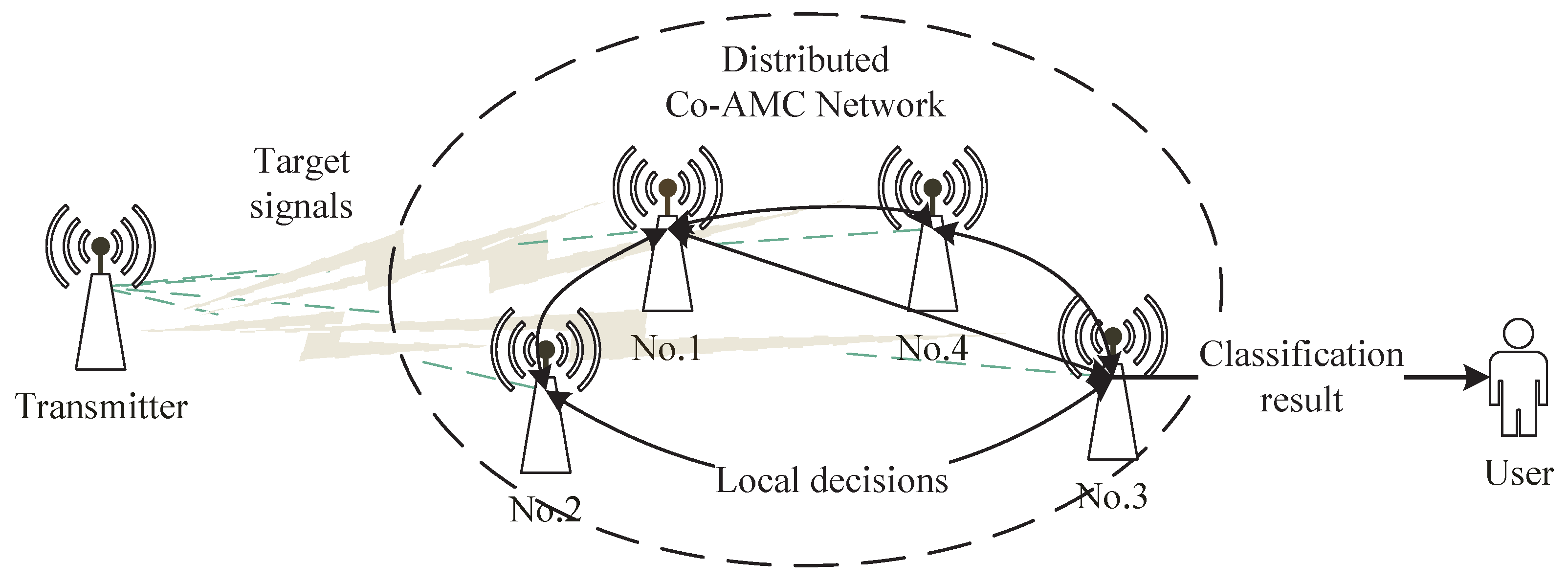

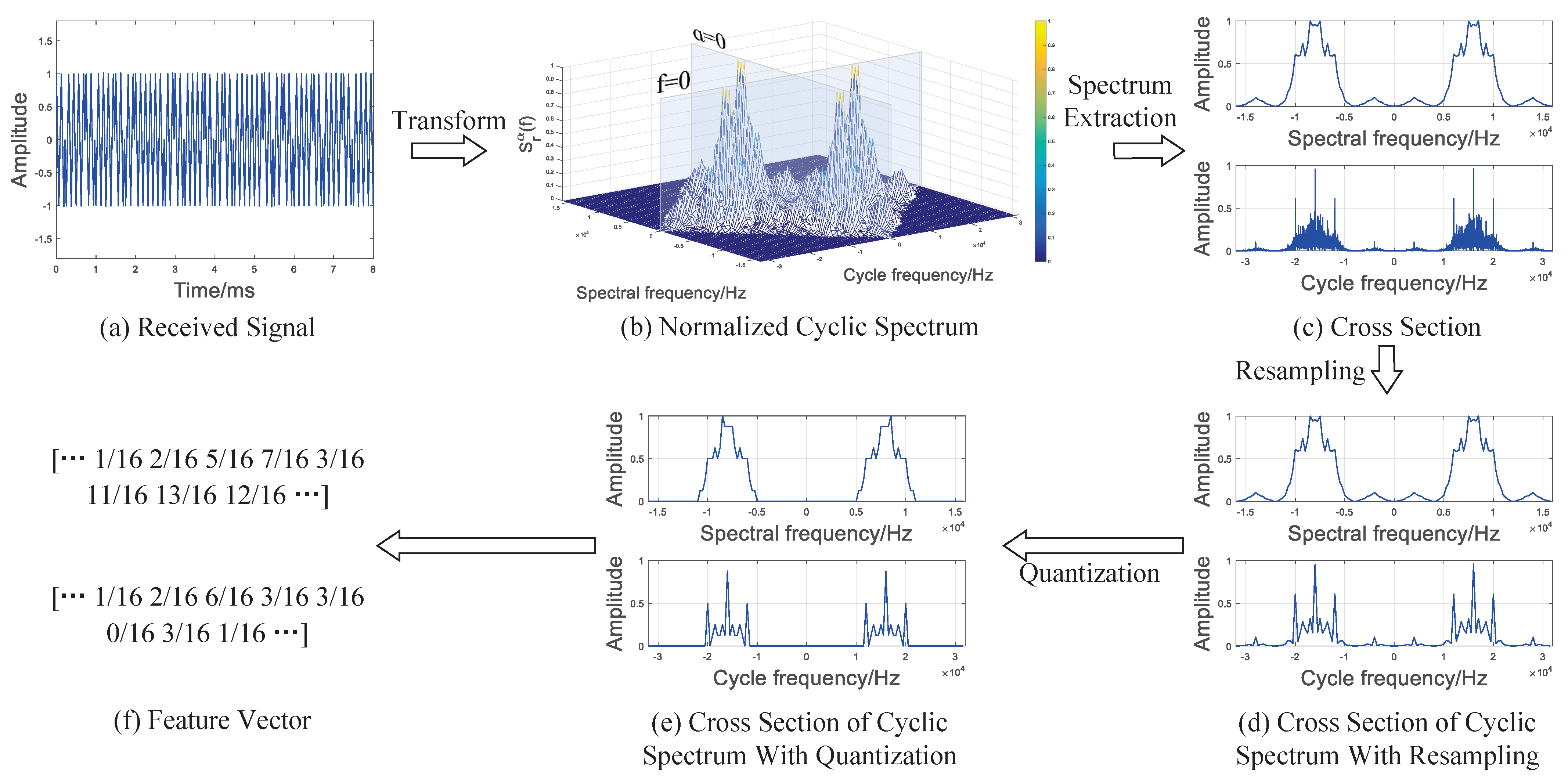
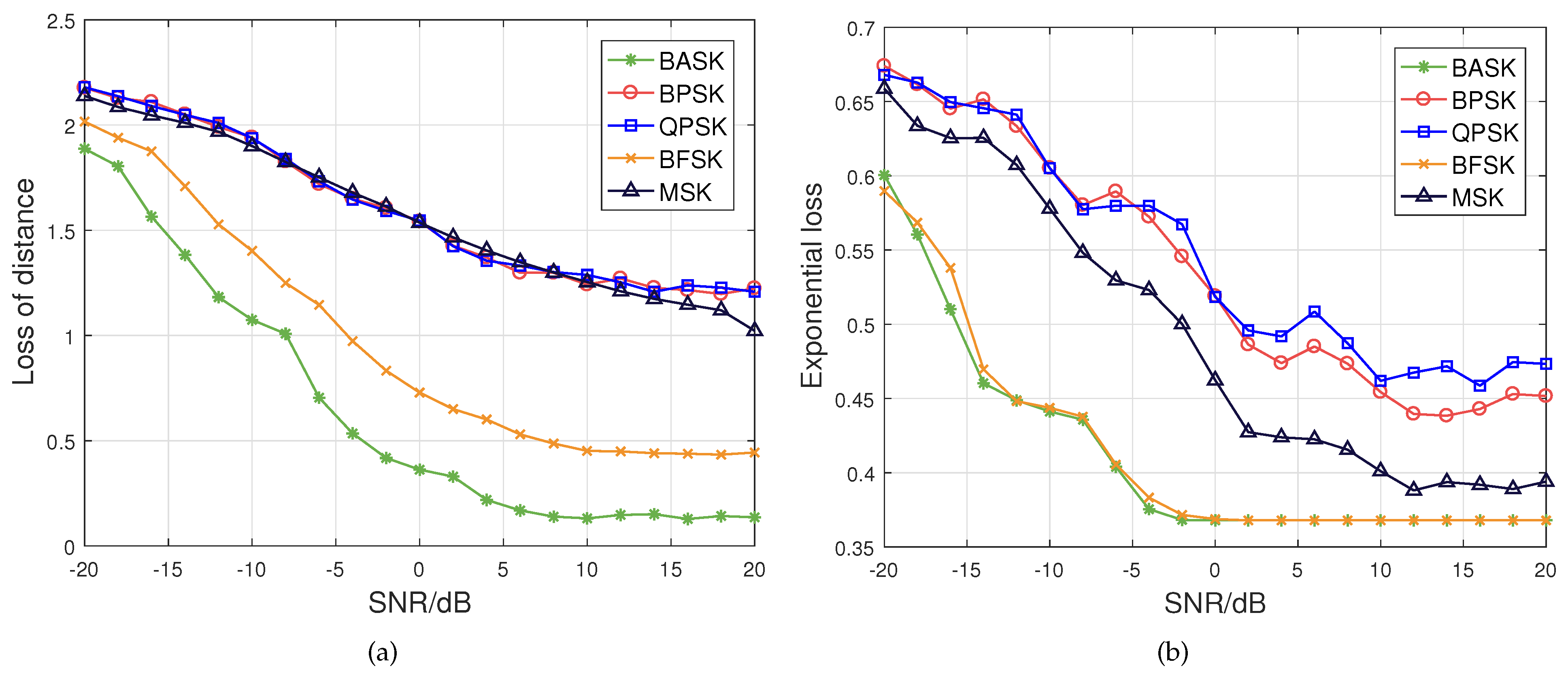
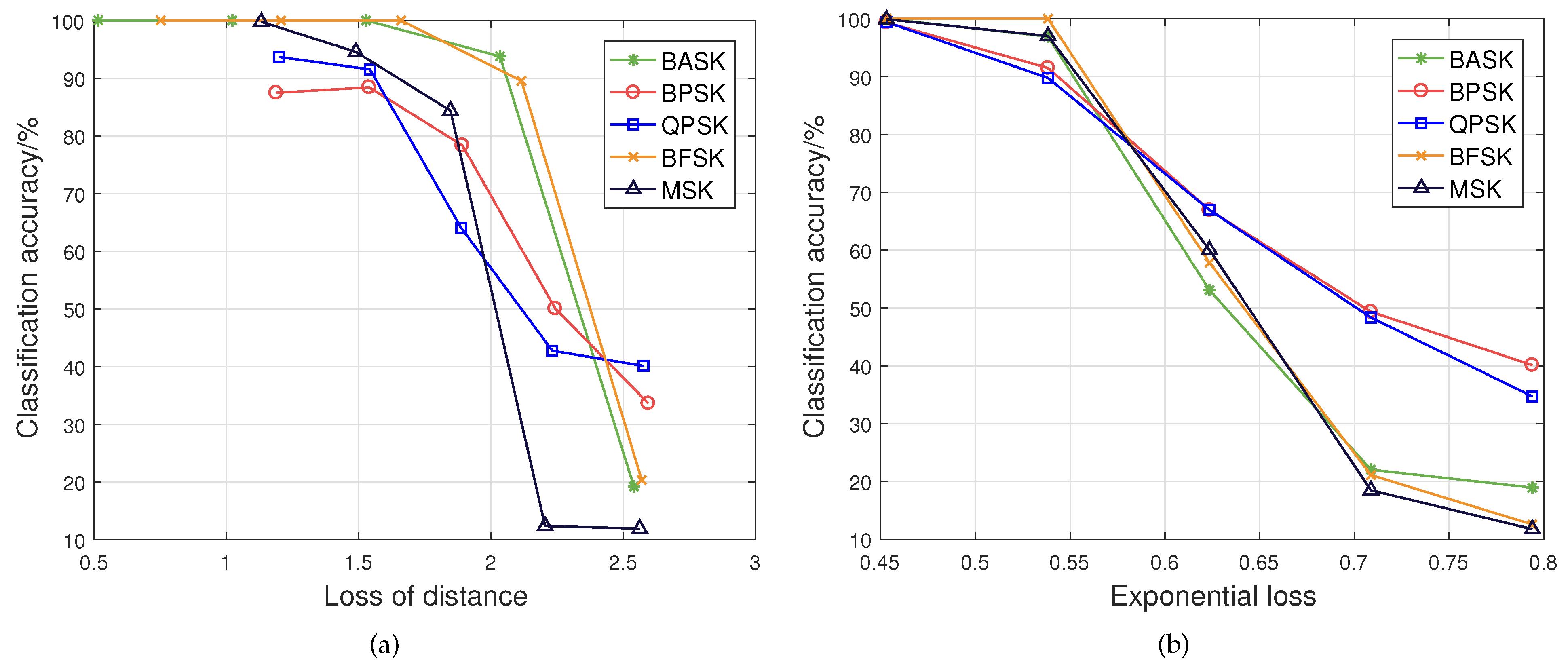

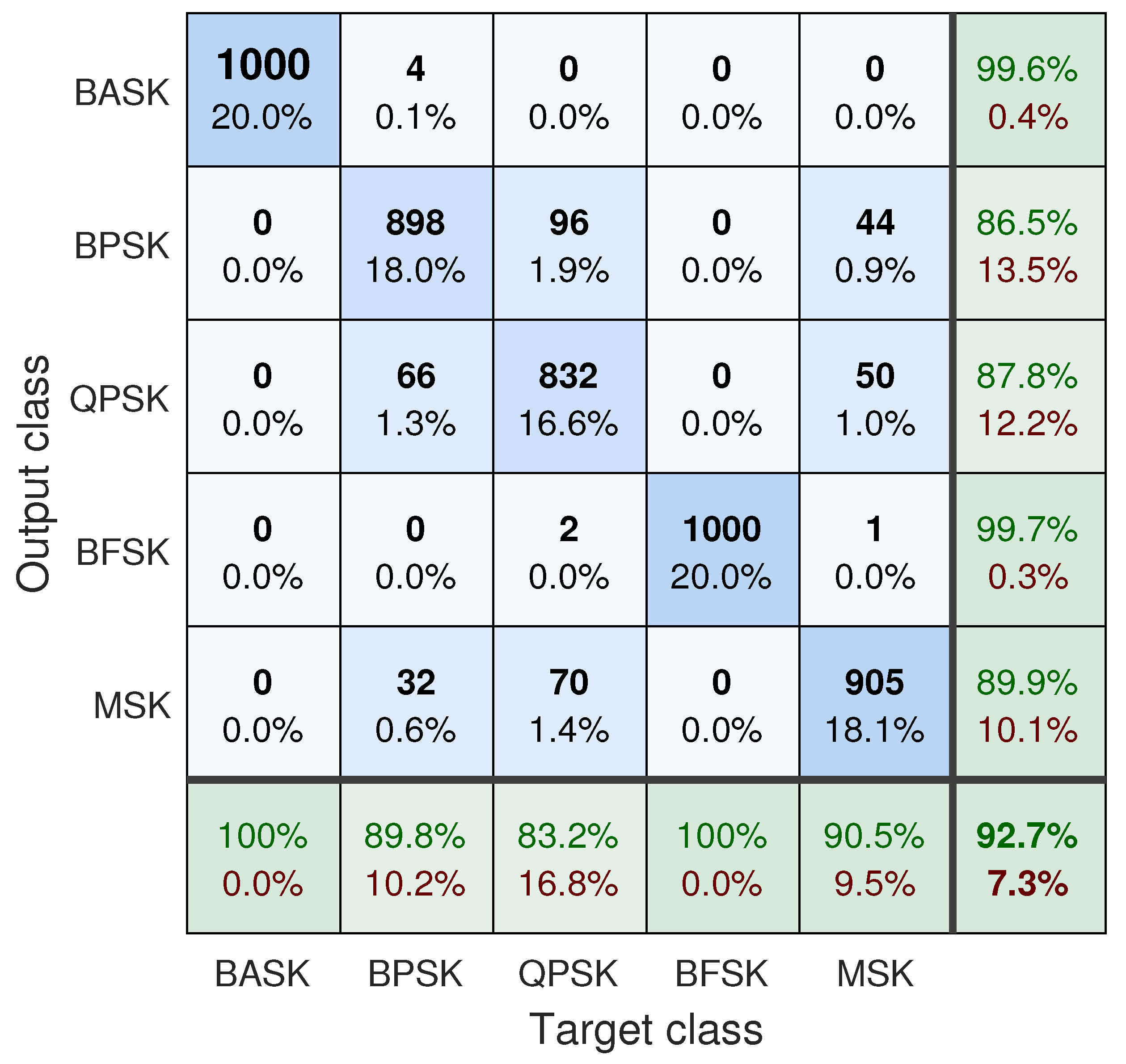
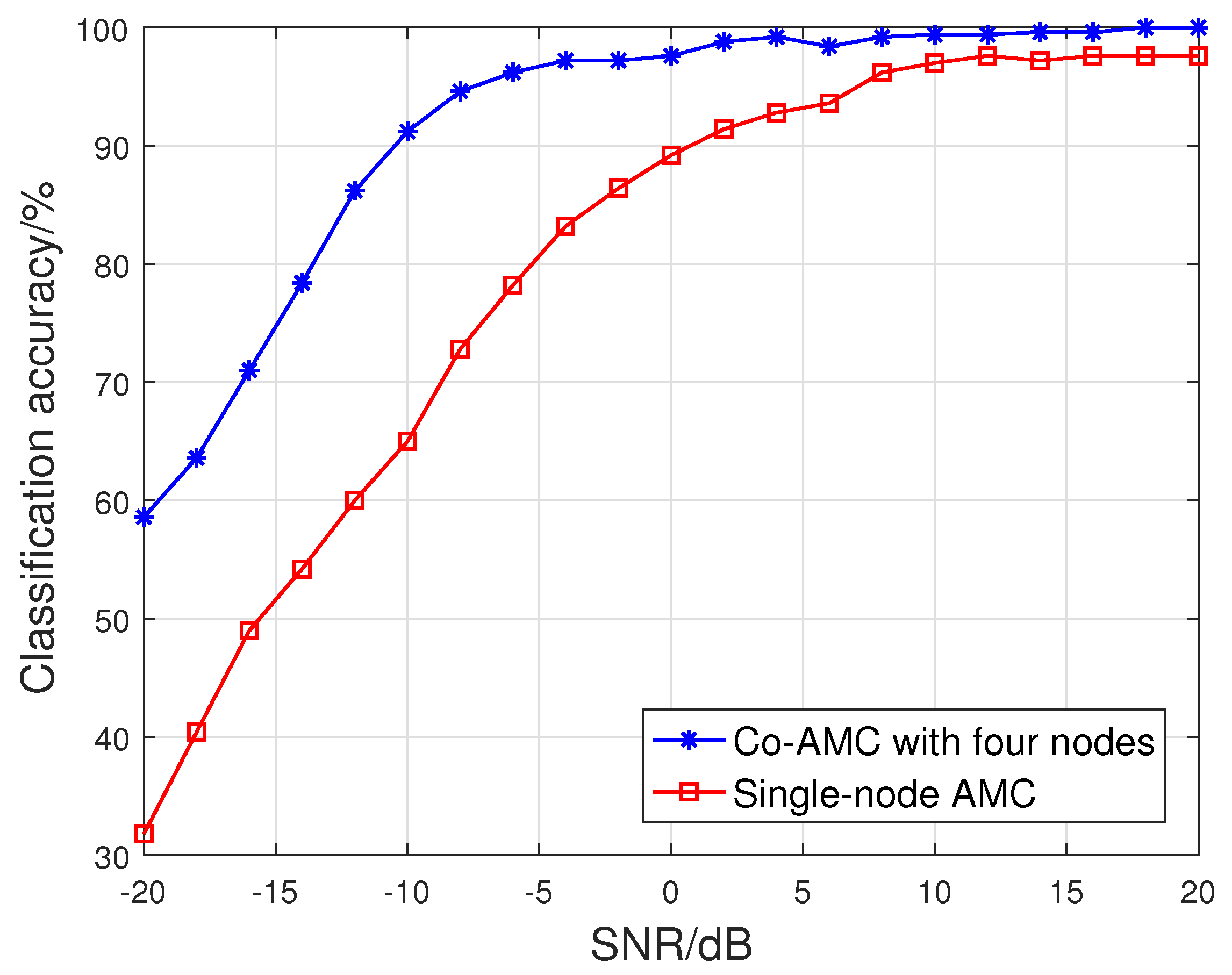
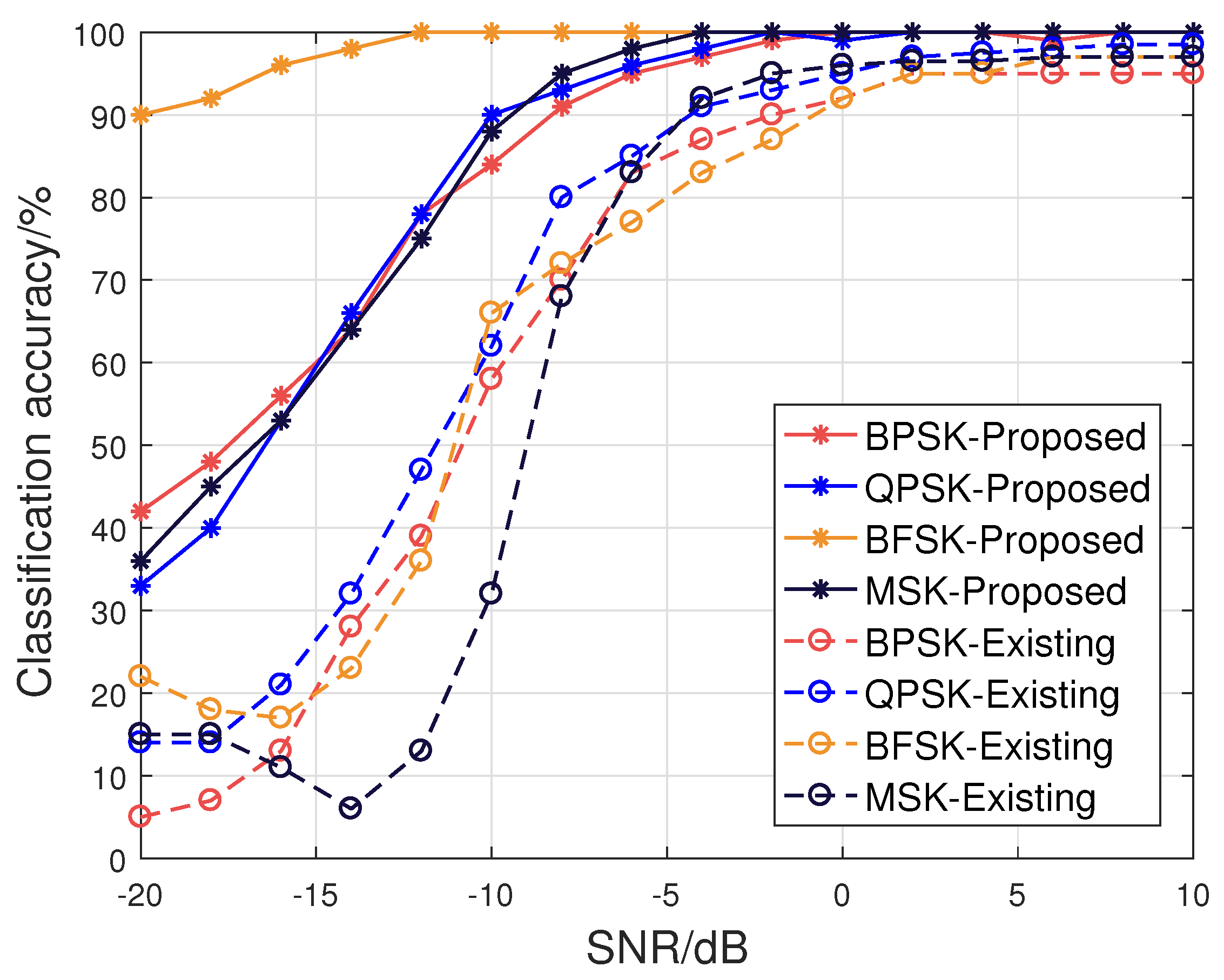


| Parameter | Description |
|---|---|
| Modulation Scheme | BASK, BPSK, QPSK BFSK, and MSK |
| Number of Samples per Symbol | 16 |
| Baud Rate () | 2 kHz or 4 kHz |
| Frequency Offset | −5 kHz∼5 kHz |
| Number of Distributed Nodes in Receiver | 4 or 8 or 16 |
| Time Delay of Received Signal | 0∼10 |
| SNR | −20 dB∼20 dB |
| Modulation Scheme | Cross Section with | Cross Section with |
|---|---|---|
| BASK | Spectral line: | 2 peaks: |
| BPSK | Spectrum with bandwidth: | 6 peaks: and |
| QPSK | Spectrum with bandwidth: | No distinct peaks |
| BFSK | Spectral line: and | 4 peaks: and |
| MSK | Spectrum with bandwidth: | 4 peaks: |
Disclaimer/Publisher’s Note: The statements, opinions and data contained in all publications are solely those of the individual author(s) and contributor(s) and not of MDPI and/or the editor(s). MDPI and/or the editor(s) disclaim responsibility for any injury to people or property resulting from any ideas, methods, instructions or products referred to in the content. |
© 2023 by the authors. Licensee MDPI, Basel, Switzerland. This article is an open access article distributed under the terms and conditions of the Creative Commons Attribution (CC BY) license (https://creativecommons.org/licenses/by/4.0/).
Share and Cite
Zhang, Q.; Guan, Y.; Li , H.; Song, Z. Distributed Cooperative Automatic Modulation Classification Using DWA-ADMM in Wireless Communication Networks. Electronics 2023, 12, 3002. https://doi.org/10.3390/electronics12143002
Zhang Q, Guan Y, Li H, Song Z. Distributed Cooperative Automatic Modulation Classification Using DWA-ADMM in Wireless Communication Networks. Electronics. 2023; 12(14):3002. https://doi.org/10.3390/electronics12143002
Chicago/Turabian StyleZhang, Qin, Yutong Guan, Hai Li , and Zhengyu Song. 2023. "Distributed Cooperative Automatic Modulation Classification Using DWA-ADMM in Wireless Communication Networks" Electronics 12, no. 14: 3002. https://doi.org/10.3390/electronics12143002
APA StyleZhang, Q., Guan, Y., Li , H., & Song, Z. (2023). Distributed Cooperative Automatic Modulation Classification Using DWA-ADMM in Wireless Communication Networks. Electronics, 12(14), 3002. https://doi.org/10.3390/electronics12143002






